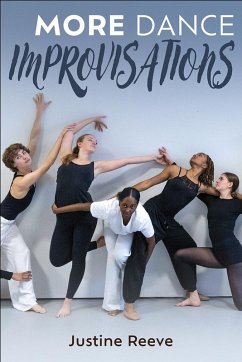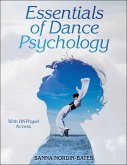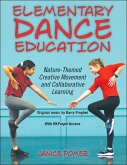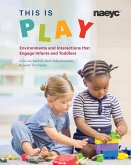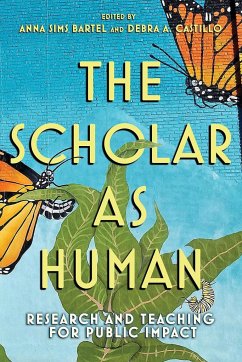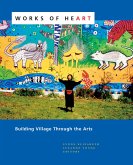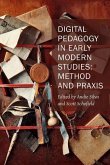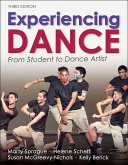Justine Reeve
More Dance Improvisations
Justine Reeve
More Dance Improvisations
- Broschiertes Buch
- Merkliste
- Auf die Merkliste
- Bewerten Bewerten
- Teilen
- Produkt teilen
- Produkterinnerung
- Produkterinnerung
Seventy-eight brand-new activities to help dancers explore movement. Wealth of creative ideas for all dancers. Expert instruction in planning, teaching, and assessing improvisations. Use improvs for individual lessons or to develop an entire lesson plan. Great for individual and group instruction.
Andere Kunden interessierten sich auch für
![Essentials of Dance Psychology Essentials of Dance Psychology]() Sanna Nordin-BatesEssentials of Dance Psychology106,99 €
Sanna Nordin-BatesEssentials of Dance Psychology106,99 €![Elementary Dance Education Elementary Dance Education]() Janice PomerElementary Dance Education50,99 €
Janice PomerElementary Dance Education50,99 €![This is Play This is Play]() Julia LuckenbillThis is Play45,99 €
Julia LuckenbillThis is Play45,99 €![The Scholar as Human The Scholar as Human]() The Scholar as Human21,99 €
The Scholar as Human21,99 €![Works of Heart Works of Heart]() Lynne ElizabethWorks of Heart34,99 €
Lynne ElizabethWorks of Heart34,99 €![Digital Pedagogy in Early Modern Studies - Method and Praxis Digital Pedagogy in Early Modern Studies - Method and Praxis]() Andie SilvaDigital Pedagogy in Early Modern Studies - Method and Praxis79,99 €
Andie SilvaDigital Pedagogy in Early Modern Studies - Method and Praxis79,99 €![Experiencing Dance Experiencing Dance]() Marty SpragueExperiencing Dance116,99 €
Marty SpragueExperiencing Dance116,99 €-
-
-
Seventy-eight brand-new activities to help dancers explore movement. Wealth of creative ideas for all dancers. Expert instruction in planning, teaching, and assessing improvisations. Use improvs for individual lessons or to develop an entire lesson plan. Great for individual and group instruction.
Hinweis: Dieser Artikel kann nur an eine deutsche Lieferadresse ausgeliefert werden.
Hinweis: Dieser Artikel kann nur an eine deutsche Lieferadresse ausgeliefert werden.
Produktdetails
- Produktdetails
- Verlag: Human Kinetics Publishers
- Seitenzahl: 200
- Erscheinungstermin: 5. September 2023
- Englisch
- Abmessung: 228mm x 156mm x 15mm
- Gewicht: 332g
- ISBN-13: 9781718222427
- ISBN-10: 1718222424
- Artikelnr.: 68315500
- Herstellerkennzeichnung
- Libri GmbH
- Europaallee 1
- 36244 Bad Hersfeld
- gpsr@libri.de
- Verlag: Human Kinetics Publishers
- Seitenzahl: 200
- Erscheinungstermin: 5. September 2023
- Englisch
- Abmessung: 228mm x 156mm x 15mm
- Gewicht: 332g
- ISBN-13: 9781718222427
- ISBN-10: 1718222424
- Artikelnr.: 68315500
- Herstellerkennzeichnung
- Libri GmbH
- Europaallee 1
- 36244 Bad Hersfeld
- gpsr@libri.de
Justine Reeve has taught for over 29 years—across all age ranges—and her roles have included teacher, department head, youth dance artistic director, choreographer and consultant. Ms. Reeve earned her BA (with honours) in dance and related arts and a postgraduate diploma in dance and collaborative arts from the University of Chichester in West Sussex, England, and a postgraduate certificate in education (PGCE). She was the artistic director of the West Sussex Youth Dance Company and a standards verifier for Edexcel/Pearson BTEC levels 2 and 3. She was an A-level dance examiner/moderator for AQA. She is presently an external expert for Ofqual and a moderator for the WJEC exam board. Ms. Reeve has written units for a well-known exam board’s specifications for 10 years and has delivered continued professional development courses for teachers of dance curriculum (key stages 4 and 5) in the United Kingdom for 20 years. She has written published dance resources for the English National Ballet, Russell Maliphant Dance Company, RSL, Rambert Dance Company, Pearson Education and the London Curriculum for the Mayor of London. She has been the director of dance at the BRIT School, a dance animateur with Rambert Dance Company and a choreographer with her own company, Puppik Dance. She enjoys visiting the theatre, reading and raising her family.
Chapter 1. Introduction and How to Use This Book
This chapter explores how to use this book, warming up and safe practice,
effective planning, top tips for dance improvisation, planning your
workshop, inclusive practice, and finding the right music, musicality,
phrases and a table of improvisations.
Chapter 2. Warm-Up Games and Tasks
This chapter explores the concepts of play and spontaneous movement as
stimuli for warming up the body and preparing the mind for new experiences.
The games and improvisations within will prepare dancers for the creative
tasks ahead, improve reaction times and explore key features of movement.
Chapter 3. Solo and Duo Improvisations
This chapter explores the movement responses dancers can generate on their
own and with partners. Through these tasks, they’ll discover spontaneous
movement answers that will develop, challenge and refine their creative
responses, solo or in duos.
Chapter 4. Group Creative Tasks
This chapter explores the movement responses dancers can generate in
groups. By working with others, they can explore and discover new movement
ideas. The tasks within aim to develop, challenge and refine creative
responses and the feeling of working as a team that comes with making group
decisions in the moment.
Chapter 5. Moving Beyond the Kinaesthetic: Using Physical and Aural
Improvisation Tasks
This chapter explores how starting with elements of physical and aural
settings can lead students to create interesting dance. It acts as a taster
for being inspired by external stimuli and will hopefully inspire an
abundance of future ideas.
Chapter 6. Developing Improvisations
This chapter encourages dancers to use the movements, phrases and sequences
created in previous tasks to play with development and structuring to
manipulate the movement material. They can also develop ideas using
existing material and repertoire. These are only a few suggestions to
inspire additional ideas on how to develop movements into dance pieces or
works.
This chapter explores how to use this book, warming up and safe practice,
effective planning, top tips for dance improvisation, planning your
workshop, inclusive practice, and finding the right music, musicality,
phrases and a table of improvisations.
Chapter 2. Warm-Up Games and Tasks
This chapter explores the concepts of play and spontaneous movement as
stimuli for warming up the body and preparing the mind for new experiences.
The games and improvisations within will prepare dancers for the creative
tasks ahead, improve reaction times and explore key features of movement.
Chapter 3. Solo and Duo Improvisations
This chapter explores the movement responses dancers can generate on their
own and with partners. Through these tasks, they’ll discover spontaneous
movement answers that will develop, challenge and refine their creative
responses, solo or in duos.
Chapter 4. Group Creative Tasks
This chapter explores the movement responses dancers can generate in
groups. By working with others, they can explore and discover new movement
ideas. The tasks within aim to develop, challenge and refine creative
responses and the feeling of working as a team that comes with making group
decisions in the moment.
Chapter 5. Moving Beyond the Kinaesthetic: Using Physical and Aural
Improvisation Tasks
This chapter explores how starting with elements of physical and aural
settings can lead students to create interesting dance. It acts as a taster
for being inspired by external stimuli and will hopefully inspire an
abundance of future ideas.
Chapter 6. Developing Improvisations
This chapter encourages dancers to use the movements, phrases and sequences
created in previous tasks to play with development and structuring to
manipulate the movement material. They can also develop ideas using
existing material and repertoire. These are only a few suggestions to
inspire additional ideas on how to develop movements into dance pieces or
works.
Chapter 1. Introduction and How to Use This Book
This chapter explores how to use this book, warming up and safe practice,
effective planning, top tips for dance improvisation, planning your
workshop, inclusive practice, and finding the right music, musicality,
phrases and a table of improvisations.
Chapter 2. Warm-Up Games and Tasks
This chapter explores the concepts of play and spontaneous movement as
stimuli for warming up the body and preparing the mind for new experiences.
The games and improvisations within will prepare dancers for the creative
tasks ahead, improve reaction times and explore key features of movement.
Chapter 3. Solo and Duo Improvisations
This chapter explores the movement responses dancers can generate on their
own and with partners. Through these tasks, they’ll discover spontaneous
movement answers that will develop, challenge and refine their creative
responses, solo or in duos.
Chapter 4. Group Creative Tasks
This chapter explores the movement responses dancers can generate in
groups. By working with others, they can explore and discover new movement
ideas. The tasks within aim to develop, challenge and refine creative
responses and the feeling of working as a team that comes with making group
decisions in the moment.
Chapter 5. Moving Beyond the Kinaesthetic: Using Physical and Aural
Improvisation Tasks
This chapter explores how starting with elements of physical and aural
settings can lead students to create interesting dance. It acts as a taster
for being inspired by external stimuli and will hopefully inspire an
abundance of future ideas.
Chapter 6. Developing Improvisations
This chapter encourages dancers to use the movements, phrases and sequences
created in previous tasks to play with development and structuring to
manipulate the movement material. They can also develop ideas using
existing material and repertoire. These are only a few suggestions to
inspire additional ideas on how to develop movements into dance pieces or
works.
This chapter explores how to use this book, warming up and safe practice,
effective planning, top tips for dance improvisation, planning your
workshop, inclusive practice, and finding the right music, musicality,
phrases and a table of improvisations.
Chapter 2. Warm-Up Games and Tasks
This chapter explores the concepts of play and spontaneous movement as
stimuli for warming up the body and preparing the mind for new experiences.
The games and improvisations within will prepare dancers for the creative
tasks ahead, improve reaction times and explore key features of movement.
Chapter 3. Solo and Duo Improvisations
This chapter explores the movement responses dancers can generate on their
own and with partners. Through these tasks, they’ll discover spontaneous
movement answers that will develop, challenge and refine their creative
responses, solo or in duos.
Chapter 4. Group Creative Tasks
This chapter explores the movement responses dancers can generate in
groups. By working with others, they can explore and discover new movement
ideas. The tasks within aim to develop, challenge and refine creative
responses and the feeling of working as a team that comes with making group
decisions in the moment.
Chapter 5. Moving Beyond the Kinaesthetic: Using Physical and Aural
Improvisation Tasks
This chapter explores how starting with elements of physical and aural
settings can lead students to create interesting dance. It acts as a taster
for being inspired by external stimuli and will hopefully inspire an
abundance of future ideas.
Chapter 6. Developing Improvisations
This chapter encourages dancers to use the movements, phrases and sequences
created in previous tasks to play with development and structuring to
manipulate the movement material. They can also develop ideas using
existing material and repertoire. These are only a few suggestions to
inspire additional ideas on how to develop movements into dance pieces or
works.

